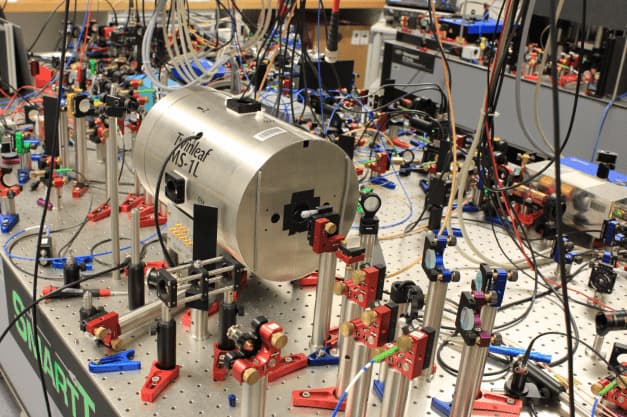Finding a reliable way to store quantum information is at the heart of efforts to build a quantum Internet. Unlike classical data, quantum information cannot be copied or amplified, and while the classical Internet transmits data via mature technologies like routers and switches that link cobwebs of wires and cables, the building blocks of the quantum Internet are still under construction.
Similarly, every piece of a classical electronic system has a buffer where information can stay temporarily before it is processed, but finding a way to “remember” fragile quantum states is a long-standing challenge.
The University of Basel lab where the rubidium vapour cell quantum memory was developed. The vapour cell is at the centre, protected by magnetic shielding.
Researchers at the University of Basel, Switzerland have now demonstrated such a quantum memory. In their experiment, a glass bulb filled with rubidium gas (a vapour cell) receives incoming photons transporting quantum information, stores that information temporarily and then produces new photons to carry the information away. What is more, unlike many quantum systems, the vapour cell quantum memory can operate at or above room temperature and is relatively simple to assemble – making it a perfect candidate for deployment in quantum networks.
Photons in transit
The key feature that makes quantum communication so challenging is also a big part of its appeal. Because information stored in the quantum states of photons cannot be copied (unlike electronic signals passing through a cable), a malicious third party cannot intercept quantum data without alerting the sender or the receiver.
However, since quantum data cannot be copied, it also cannot be readily amplified. Without amplification, the signal travelling along a fibre-optic cable grows weaker over distance. This limits data transmission to a few hundred kilometres at best.
One way of avoiding this problem is to introduce repeaters between the sender and the recipient. Any two repeaters can exchange photons to entangle their respective memories. The shared entanglement can then be used to teleport information from one end to another.
Storing and retrieving photons
As the routers relay the quantum information, they need a way to store the information temporarily before passing it securely to the next station. This is where quantum memories come in.
For the experiment in Basel, the researchers began by initializing the rubidium atoms in their vapour cell into a ground state. When incoming photons from a single-photon source interact with a rubidium atom in this cell, the atom enters a superposition of quantum states. This process can be reversed to make the vapour cell emit photons containing the information it just absorbed.
While quantum memories have been a popular object of study, there hasn’t previously been a way to operate them reliably at or above room temperature. According to Gianni Buser, the lead author of a paper in PRX Quantum about the research, devices based on cold atoms have demonstrated an efficient interface between photon sources and memories. These experiments, however, are slow and have low bandwidth. Plus, it is cumbersome to set up cold atom memories outside a laboratory. Using a vapour cell ensures that the device can be used above room-temperature in a wide range of use cases – something that is important when you “consider how ubiquitously memory is used in classical networking and communication,” Buser adds, noting that such a fundamental building block also needs to be very robust.
A further challenge with memories based on vapour cells is reading out photons after storage. A memory is only meaningful if the information stored in it can be read out reliably, but in a vapour cell, the atoms collide with each other and with the walls of the cell, degrading the quality of released photons. By developing techniques to mitigate read-out noise, Buser and his team managed to read photons stored for several hundred nanoseconds – a tiny duration on a human scale, but a long time for the photon pulses used in the experiment, which are themselves only a few nanoseconds long.
According to Buser, there are straightforward ways to improve his team’s result. “The published experiment relies on a pretty ordinary, commercially available, rubidium cell. A collaboration with vapour cell specialists could go a long way towards making the heart of the experiment more suited to its purpose,” he says. Coating the cell with substances like paraffin also mitigates quantum information being lost as atoms crash against the walls of the cell. In fact, Buser is optimistic that storage times for the memory could reach values on the order of a second, which he notes “is truly an eternity for a photon”.
